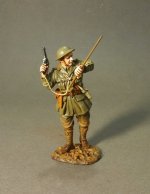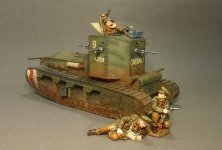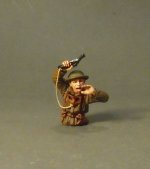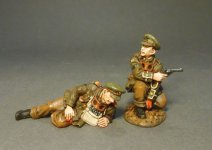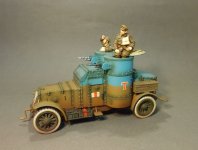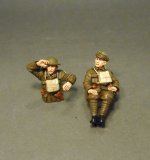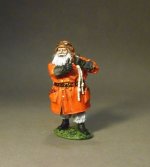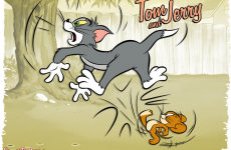THE GREAT WAR 1914-1918
It was decided that the operation of these Anti Aircraft guns would be the responsibility of the Royal Garrison Artillery.
Each Anti-Aircraft section comprised of two lorry mounted guns, one staff car and one motorcycle.
The sections were used to protect targets likely to be attacked by enemy aeroplanes such as ammunition dumps, observation balloons, and railheads.
The gun trucks would find somewhere suitable to set up (a sunken road being an ideal location) and make themselves comfortable while waiting for the enemy to fly into range.
Once an enemy plane was identified the gun would be brought into action. It was extremely difficult to identify the speed and height of a moving aeroplane, and then setting the appropriate fuse, was far from easy! It became a widely held belief that if enough rounds were fired into the air they would eventually hit something……
In 1917 only 95 aircraft were shot down by antiaircraft fire.
With the development of new equipment, such as the Wilson Dalby Tracker, and the Barr and Stroud UB2 Rangefinder, this was to improve, and 176 were recorded as being shot down the following year.
It was estimated that for each enemy plane shot down, 4,000-4,500 shells were fired.
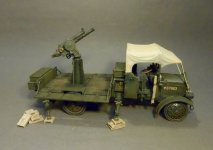
GWB-50
THE GREAT WAR, 1914-1918,
Thorneycroft Truck with Anti-Aircraft Gun,
(9pcs)
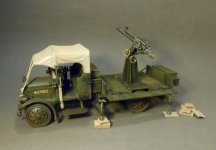
** Please note at this time I have completed 0 of the crew!. But they are on the workbench**
After having gone into action against an enemy plane, the antiaircraft section might become subject to German counter-battery fire, and it would therefore have to pack up and quickly move to a different location.
This would leave any other units who were located nearby on the receiving end of the German’s wrath, so a newly arriving antiaircraft section was not always given a friendly greeting.
Each figure will be produced in 3 different regiment markings.
The different regiments are distinguished by the different Unit Colour Patches, which were worn on the shoulder.
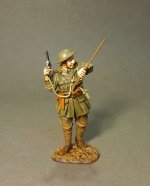
GWA-02(60)
THE GREAT WAR, 1914-1918, AUSTRALIAN IMPERIAL FORCE, BATTLE OF AMIENS, 6th August 1918,
The 5th Division, 15th Brigade, 60th Battalion,
Infantry Officer,
(1pc)
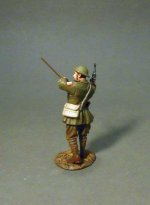
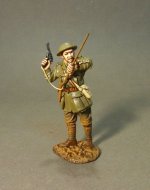
GWA-02(31)
THE GREAT WAR, 1914-1918, AUSTRALIAN IMPERIAL FORCE, BATTLE OF AMIENS, 6th August 1918,
The 5th Division, 8th Brigade, 31st Battalion,
Infantry Officer,
(1pc)
More to come..................................
It was decided that the operation of these Anti Aircraft guns would be the responsibility of the Royal Garrison Artillery.
Each Anti-Aircraft section comprised of two lorry mounted guns, one staff car and one motorcycle.
The sections were used to protect targets likely to be attacked by enemy aeroplanes such as ammunition dumps, observation balloons, and railheads.
The gun trucks would find somewhere suitable to set up (a sunken road being an ideal location) and make themselves comfortable while waiting for the enemy to fly into range.
Once an enemy plane was identified the gun would be brought into action. It was extremely difficult to identify the speed and height of a moving aeroplane, and then setting the appropriate fuse, was far from easy! It became a widely held belief that if enough rounds were fired into the air they would eventually hit something……
In 1917 only 95 aircraft were shot down by antiaircraft fire.
With the development of new equipment, such as the Wilson Dalby Tracker, and the Barr and Stroud UB2 Rangefinder, this was to improve, and 176 were recorded as being shot down the following year.
It was estimated that for each enemy plane shot down, 4,000-4,500 shells were fired.

GWB-50
THE GREAT WAR, 1914-1918,
Thorneycroft Truck with Anti-Aircraft Gun,
(9pcs)

** Please note at this time I have completed 0 of the crew!. But they are on the workbench**
After having gone into action against an enemy plane, the antiaircraft section might become subject to German counter-battery fire, and it would therefore have to pack up and quickly move to a different location.
This would leave any other units who were located nearby on the receiving end of the German’s wrath, so a newly arriving antiaircraft section was not always given a friendly greeting.
Each figure will be produced in 3 different regiment markings.
The different regiments are distinguished by the different Unit Colour Patches, which were worn on the shoulder.

GWA-02(60)
THE GREAT WAR, 1914-1918, AUSTRALIAN IMPERIAL FORCE, BATTLE OF AMIENS, 6th August 1918,
The 5th Division, 15th Brigade, 60th Battalion,
Infantry Officer,
(1pc)


GWA-02(31)
THE GREAT WAR, 1914-1918, AUSTRALIAN IMPERIAL FORCE, BATTLE OF AMIENS, 6th August 1918,
The 5th Division, 8th Brigade, 31st Battalion,
Infantry Officer,
(1pc)
More to come..................................


